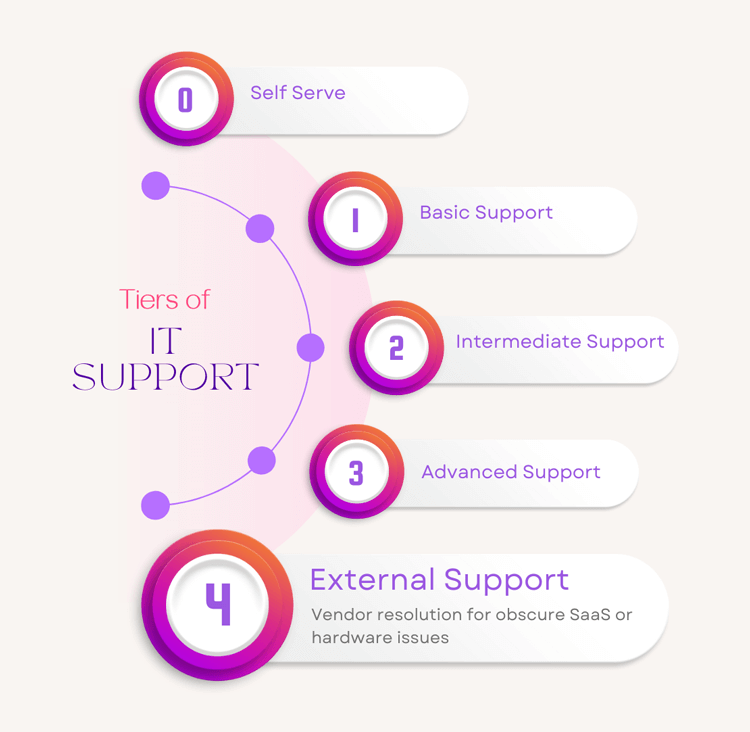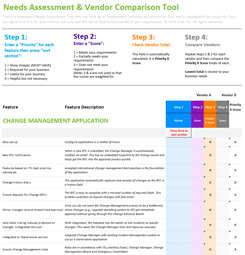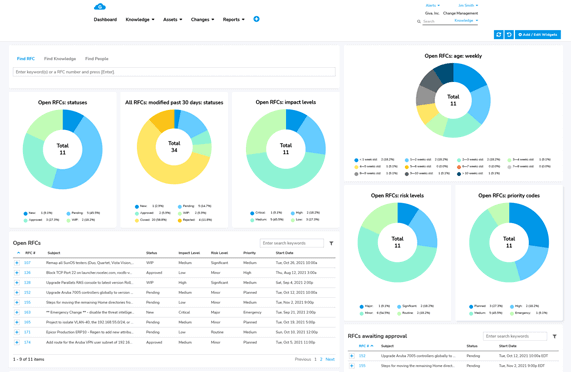Learn the ITIL Change Management Process Fully: A Complete Guide
ITIL Change Management, also now known as ITIL Change Enablement as of the version 4 release of ITIL in 2018, is the process of managing change within an IT and ITSM team and organization.
The Information Technology Infrastructure Library, or ITIL®, has been around for a long time, originating when British government departments, or agencies as they're known in the US, were struggling to get used to IT and computers in the workplace.
It evolved into a complete IT-based operational and educational discipline that IT teams and managers can train and certify in (it's ISO 20000 certified and courses are managed and accredited by Axelos).
In this article, we provide more detail on the ITIL Change Management Process, including best practices and how to implement change management.

What is ITIL Change Management?
ITIL Change Management is a structured process designed to oversee the lifecycle of IT changes--from proposal to implementation and post-deployment review.
The theory behind implementing this using ITIL methodology is to maximize the number of successful IT changes by making sure risks have been appropriately assessed, authorizing changes to proceed, and managing the Change Schedule.
The aim of ITIL Change Management is to manage changes efficiently while maintaining service reliability, stability, and availability.
IT changes can include any of the following:
- System upgrades
- Network modifications
- Security patches
- Introducing new software and new devices
- Replacing legacy software for a cloud-based SaaS solution
- Changes to infrastructure configurations
The ITIL framework breaks down IT changes into the following categories:
- Standard changes (low-risk, routine)
- Normal changes (moderate risk)
- Major changes (high risk, can generate a significant ROI)
- Emergency changes (high priority, critical situations)
The ITIL Change Management Process ensures that every change is reviewed, authorized, prioritized, tested, and tracked to minimize business risk.
Why is ITIL Change Management Important?
For CIOs and IT leaders, change is constant, and usually an operational necessity. Whether driven by new business requirements, security updates, or innovation, the need for change introduces potential risks.
Unstructured and unplanned changes cause disruption and, potentially, unexpected downtime. ITIL Change Management (or Enablement) is designed to prevent disruption caused by unplanned and disorganized changes.
Without this kind of structured approach, changes can lead to service disruptions, security vulnerabilities, or system failures.
Here's why ITIL Change Management is beneficial:
- Minimizes Risk: ITIL processes ensure that risks are minimized by evaluating and assessing the risks associated with any and every IT-based change. This includes the process ensures that potential disruptions are identified and mitigated before implementation.
- Increases Efficiency: ITIL change management processes standardize change approval workflows. This helps eliminate bottlenecks, improve communication, and streamline ITSM changes.
- Enhances Transparency and Communication: Change management improves visibility across teams. This helps ensure everyone is informed about upcoming changes and potential impacts on systems.
- Supports Compliance: For industries subject to regulations (like healthcare or finance), ITIL Change Management helps keep changes aligned with compliance standards, with proper documentation and audit trails.
Now, let's look at the types of ITIL change management processes that IT teams usually deal with.
4 Types of ITIL Change Management
ITIL Change Management classifies changes based on their level of risk, urgency, and frequency:
-
Standard Changes
These are low-risk, pre-approved changes that follow a streamlined process. Standard changes are routine, predictable, and often repeatable, such as updating software patches or replacing hardware components. The Change Manager defines Standard change requirements. Once a change request meets the relevant criteria (e.g., Low Risk, Well Understood), it will receive pre-authorization for future requests, as well, if the changes are the same as those previously approved.
-
Normal Changes
These involve a higher level of risk and require a more detailed approval process. Each normal change is unique, and it must go through formal risk assessment, planning, and approval. Examples include network upgrades or integrating new software into existing systems. These should always be approved by the Change Advisory Board (CAB).
-
Major Changes
This is beyond a normal change, such as a platform migration or a major consumer-facing app upgrade. It could also be implementing new hardware and software that will impact the entire organization.
-
Emergency Changes
These changes are critical and must be implemented as soon as possible to restore service or prevent major disruptions. At times, emergency changes bypass the typical review and approval processes but must still be documented and reviewed post-implementation to assess their impact and potential for improvement. If there's time, then these changes need to be approved by the Emergency Change Advisory Board (ECAB).
Understanding these types of changes in ITIL helps IT teams assign the right level of oversight and approval to each, ensuring effective management of IT resources.
ITIL Change Management Process: 5 Steps to Success
The ITIL Change Management Process involves several key steps that ensure all IT changes are planned, reviewed, and executed efficiently while minimizing the potential for failure:
-
Change Request, Known as a Request for Change (RFC)
A change to IT systems, processes, hardware, or software is initiated with a formal Request for Change (RFC). This document outlines the details of the proposed change, including its scope, objectives, potential risks, and expected outcomes. This is usually when a change is either standard or normal (and has not been previously approved), rather than an emergency, when there might not be time for an RFC.
-
Change Assessment and Approval
Each change is evaluated based on its potential risks, business impact, and resource requirements. For high-impact changes, this step involves the Change Advisory Board (CAB), which reviews the proposal and decides whether the change should proceed. Whereas, with low-risk, easily understood (standard) changes, the CAB rarely needs to review them.
-
Change Planning and Scheduling
Once the ITIL-based RFC is approved, the change is carefully planned and scheduled. This stage includes testing the change in a controlled environment (usually a staging server or staging site) to ensure it won't disrupt other services or systems.
-
Implementation
The change is deployed according to the ITIL-based plan and timescale. During this phase, the IT team closely monitors the implementation to quickly address any issues that could arise. If an issue does occur, then this needs to be fixed quickly and what happened assessed during the next phase.
-
Post-Implementation Review (PIR)
After the change has been implemented, a review is conducted to assess its success and identify areas for improvement. This is important for capturing lessons learned and enhancing future change management processes.
Now, let's look at typical examples of ITIL change management within ITSM teams and organizations.
ITIL Change Management Examples
ITIL change management impacts IT departments, teams, and IT vendors almost every week and working cycle.
In most cases, these changes are small and routine. In other cases, they're an emergency, or they have happened because of a major business change, such as buying a company and incorporating systems into one.
Here are some examples of ITIL change management in practice:
- Software Patch Deployment: A routine update to a security patch is a standard change, the lowest tier of changes, and one that usually only needs a pre-approved RFC. This simple pre-defined process ensures minimal impact on the business, and the change is pre-approved.
- Server Migration: Migrating an entire server to a new environment would be a normal change. Any kind of server or platform migration requires thorough planning, testing, and approval due to its complexity and the potential impact on business operations.
- Emergency Bug Fix: An emergency change might occur when a critical system fails, and an urgent patch needs to be applied immediately to restore services. While speed is crucial, documentation and post-implementation review ensure the process is still controlled using the ITIL process.
Change management doesn't happen by itself, or by accident. It's a carefully managed process, and this requires a coordinated team to review, approve, implement, and monitor.
Roles in ITIL Change Management
Several key roles are essential for the success of ITIL Change Management:
-
Change Initiator
The individual or team that identifies the need for a change and submits the Request for Change (RFC).
-
Practice Owner
A person responsible for everything involved with the process, including reviewing opportunities to improve efficiency and effectiveness. They also are responsible for implementing improvement opportunities for inclusion in the Continual Service Improvement (CSI) register, and making ITIL change process improvements.
-
Practice Manager
A member of an IT department (e.g., service desk), representing Change Management in the department. A practice manager could also be a line manager, (aka change manager). They are responsible for making sure the department follows practices primarily related to approving changes and coordinating with other stakeholders.
-
Change Advisory Board (CAB)
A group of IT and business stakeholders who review, approve, and prioritize significant changes. They ensure that changes align with business goals and are manageable from a risk perspective. A CAB is always overseen by a Chairperson to manage the whole end-to-end process and change-based KPIs.
For more on those involved and how CAB decisions can be made, see our role-play example CAB meeting blog post.
-
Technical IT Teams
These teams are responsible for testing, implementing, and monitoring changes during and after deployment. In most cases, they could be ITSM tier/level 2 or 3 support agents, or you might need to work with external consultants.
-
ITSM Service Desk (also known as the Help Desk)
This team is often the first point of contact for end-users and plays a critical role in communicating planned changes and addressing issues that may arise post-implementation.
Now, let's look at best practices for ITIL change management.
5 ITIL Change Management Process Best Practices
Here are 5 best practices for ITIL change management changes. They apply whether they're normal and standard or more complex and much bigger:
-
Standardize the Change Request Process
Ensure all RFCs are detailed, and consistent, and capture all of the information about the proposed change, including risks and impacts. Make sure to show risks have been evaluated, even if it's a simple and standard change.
-
Implement Rigorous Testing
Testing changes in a controlled environment before they are rolled out into production helps avoid costly disruptions.
-
Use Automation Tools
Automation can simplify routine changes (e.g., purely standard and normal ones) and reduce the administrative burden on change managers and IT teams. This helps make sure even minor changes follow established processes.
-
Define Clear Roles and Responsibilities
Make sure all ITSM team members understand their roles in the change management process, from initiation to review and implementation. Communicate this to stakeholders so they know who's responsible for the implementation and monitoring of changes.
-
Foster Communication and Collaboration
Keep all stakeholders informed at every stage of the change process. Effective communication helps prevent confusion and ensures a smooth implementation.
Challenges of ITIL Change Management
Despite its structured approach, ITIL Change Management can present some challenges:
- Resistance to Change: Introducing new processes often encounters pushback from teams that are accustomed to a certain way of doing things. Overcoming this resistance requires strong leadership and clear communication.
- Complex Approval Processes: For large organizations, the change approval process, especially for normal and emergency changes, can become bureaucratic and time-consuming. This can slow down critical IT initiatives.
- Maintaining Agility: While ITIL Change Management aims to minimize risks, there's a risk of over-structuring processes to the point where innovation and rapid development are stifled. Balancing control and agility is key.
- Insufficient Testing: Inadequate testing can lead to failed implementations, even with the best planning. Ensuring robust testing environments are in place is essential. Automated monitoring can also help to assess that everything is working as planned.
- Documentation Overload: Detailed documentation is critical for compliance and audit purposes but can sometimes become difficult for busy change managers to manage. Automation tools can help manage this workflow element by automatically documenting processes and changes.
Key Takeaways: ITIL Change Management
ITIL Change Management is an essential part of IT operations and ITSM teams. Having a structured approach to managing change, whether it's big or small, IT leaders can ensure they're balancing the need for innovation with the necessity of service stability and risk mitigation.
Giva Can Help Streamline Your IT Change Management Processes
Having the right software and systems to help with ITIL change management can make the entire process easier, and standardized, and reduce administrative complications. That's where Giva's IT Change Management application can play a partner role in your digital transformation projects, change management and other ITSM needs.
Features include:
- Flexibility to define processes to speed up approvals and manage the documentation needed to support high velocity releases
- Visibility into code and configuration changes throughout the organization by creating a central system of record of all IT changes
- Dashboards, notifications and alerts keep everyone informed, enabling more peer reviews and collaboration around releases
- Out-of-the-box services that can be easily configured to meet organizational and regulatory compliance requirements
Let Giva help you be highly organized and structured in all your IT changes. Book a free Giva demo to see our solutions in action, or start your own free, 30-day trial today!





